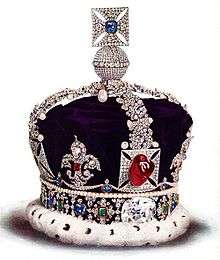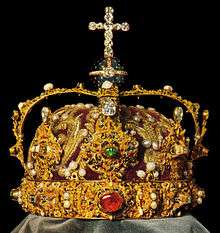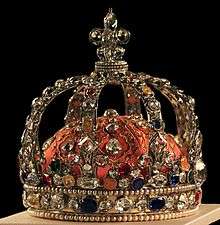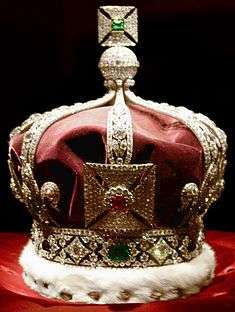Crown (headgear)



A crown is a traditional symbolic form of headwear worn by a monarch or by a deity, for whom the crown traditionally represents power, legitimacy, victory, triumph, honor, and glory, as well as immortality, righteousness, and resurrection. In art, the crown may be shown being offered to those on Earth by angels. Apart from the traditional form, crowns also may be in the form of a wreath and be made of flowers, oak leaves, or thorns and be worn by others, representing what the coronation part aims to symbolize with the specific crown. In religious art, a crown of stars is used similarly to a halo. Crowns worn by rulers often contain jewels.
As an emblem
A crown is often an emblem of the monarchy, a monarch's government, or items endorsed by it. The word itself is used, particularly in Commonwealth countries, as an abstract name for the monarchy itself, as distinct from the individual who inhabits it (see The Crown). A specific type of crown (or coronet for lower ranks of peerage) is employed in heraldry under strict rules. Indeed, some monarchies never had a physical crown, just a heraldic representation, as in the constitutional kingdom of Belgium, where no coronation ever took place; the royal installation is done by a solemn oath in parliament, wearing a military uniform: the King is not acknowledged as by divine right, but assumes the only hereditary public office in the service of the law; so he in turn will swear in all members of "his" federal government.
- Costume headgear imitating a monarch's crown is also called a crown. Such costume crowns may be worn by actors portraying a monarch, people at costume parties, or ritual "monarchs" such as the king of a Carnival krewe, or the person who found the trinket in a king cake.
- The nuptial crown, sometimes called a coronal, worn by a bride, and sometimes the bridegroom, at her wedding is found in many European cultures since ancient times. In the present day, it is most common in Eastern Orthodox cultures. The Eastern Orthodox marriage service has a section called the crowning, wherein the bride and groom are crowned as "king" and "queen" of their future household. In Greek weddings, the crowns are diadems usually made of white flowers, synthetic or real, often adorned with silver or mother of pearl. They are placed on the heads of the newlyweds and are held together by a ribbon of white silk. They are then kept by the couple as a reminder of their special day. In Slavic weddings, the crowns are usually made of ornate metal, designed to resemble an imperial crown, and are held above the newlyweds heads by their best men. A parish usually owns one set to use for all the couples that are married there since these are much more expensive than Greek-style crowns. This was common in Catholic countries in the past.
- Crowns are also often used as symbols of religious status or veneration, by divinities (or their representation such as a statue) or by their representatives, e.g. the Black Crown of the Karmapa Lama, sometimes used a model for wider use by devotees.
- A Crown of thorns according to the Bible, was placed on the head of Jesus before his crucifixion and has become a common symbol of martyrdom.
- According to Roman Catholic tradition, the Blessed Virgin Mary was crowned as Queen of Heaven after her assumption into heaven. She is often depicted wearing a crown, and statues of her in churches and shrines are ceremonially crowned during May.
- The Crown of Immortality is also common in historical symbolism.
- The heraldic symbol of Three Crowns, referring to the three evangelical Magi (wise men), traditionally called kings, is believed thus to have become the symbol of the Swedish kingdom, but it also fits the historical (personal, dynastic) Kalmar Union (1397–1520) between the three kingdoms of Denmark, Sweden, and Norway.
- Dancers of certain traditional Thai dances often wear crowns (mongkut) on their head. These are inspired in the crowns worn by deities and by kings.
- In India, crowns is known as makuta (Sanskrit for "crest"), and have been used in India since ancient times and are described adorning Hindu gods or kings.
- In pre-Hispanic Philippines, a crown-like diadems or Putong is wore by elite individuals and also deities, include array of golden ornaments.[1][2]
Terminology
Three distinct categories of crowns exist in those monarchies that use crowns or state regalia.
- Coronation: worn by monarchs when being crowned.
- State: worn by monarchs on other state occasions. (Note that similar headgear, worn by nobility and other high-ranking people below the ruler, is in English called a coronet, however in many languages the same word is used, e.g., French couronne, German Krone, Dutch kroon.)
- Consort crowns: worn by queens consort, signifying rank granted as a constitutional courtesy protocol.
In Classical antiquity, the crown (corona) that was sometimes awarded to people other than rulers, such as triumphal military generals or athletes, was actually a wreath or chaplet, or ribbon-like diadem.
History

The precursor to the crown was the browband called the diadem, which had been worn by the Achaemenid Persian emperors, was adopted by Constantine I, and was worn by all subsequent rulers of the later Roman Empire.
Numerous crowns of various forms were used in antiquity, such as the Hedjet, Deshret, the Pschent double crown, and Khepresh of Pharaonic Egypt.
The corona radiata, the "radiant crown" known best on the Statue of Liberty, and perhaps worn by the Helios that was the Colossus of Rhodes, was worn by Roman emperors as part of the cult of Sol Invictus prior to the Roman Empire's conversion to Christianity. It was referred to as "the chaplet studded with sunbeams” by Lucian, about 180 AD.[3]
Perhaps the oldest extant Christian crown in Europe is the Iron Crown of Lombardy, of Roman and Longobard age, later again used to crown modern Kings of Napoleonic and Austrian Italy, and to represent united Italy after 1860.
In the Christian tradition of European cultures, where ecclesiastical sanction authenticates monarchic power, when a new monarch assumes the throne in a coronation ceremony, the crown is placed on the new monarch's head by a religious official. Some, though not all early Holy Roman Emperors travelled to Rome at some point in their careers to be crowned by the pope. Napoleon, according to legend, surprised Pius VII when he reached out and crowned himself, although in reality this order of ceremony had been pre-arranged (see coronation).
Today, only the British Monarchy and Tongan Monarchy continue this tradition as the only remaining anointed and crowned monarchs, though many monarchies retain a crown as a national symbol in heraldry. The French Crown Jewels were sold in 1885 on the orders of the Third French Republic, with only a token number, with their precious stones replaced by glass, held on to for historic reasons and displayed by the Louvre. The Spanish Crown Jewels were destroyed in a major fire in the 18th century while the so-called "Irish Crown Jewels" (actually merely the British Sovereign's insignia of the Most Illustrious Order of St Patrick) were stolen from Dublin Castle in 1907, just before the investiture of Bernard Edward Barnaby FitzPatrick, 2nd Baron Castletown.
Special headgear to designate rulers dates back to pre-history, and is found in many separate civilizations around the globe. Commonly, rare and precious materials are incorporated into the crown, but that is only essential for the notion of crown jewels. Gold and precious jewels are common in western and oriental crowns. In the Native American civilizations of the Pre-Columbian New World, rare feathers, such as that of the quetzal, often decorated crowns; so too in Polynesia (e.g. Hawaii).
- Coronation is often combined with other rituals, such as enthronement (the throne is as much a symbol of monarchy as the crown) and anointing (again religious sanction, the only defining act in the Biblical tradition of Israel).
In other cultures, no crown is used in the equivalent of coronation, but the head may still be otherwise symbolically adorned, as a royal tikka in the Hindu tradition of India.
Image gallery
- Iron Crown of Lombardy (8th or 9th century)
 Crown of the Essen Cathedral Treasury (11th century)
Crown of the Essen Cathedral Treasury (11th century)2.jpg) Crown of the Holy Roman Empire (11th century)
Crown of the Holy Roman Empire (11th century) Medieval Crown of Bulgaria kert in the National history museum of Bulgaria
Medieval Crown of Bulgaria kert in the National history museum of Bulgaria Holy Crown of Hungary (12th century)
Holy Crown of Hungary (12th century)- Crown of Eric IX of Sweden (12th century)
 Crown of Saint Wenceslas (1347; modern replica shown)
Crown of Saint Wenceslas (1347; modern replica shown) Royal Crown of Sweden (1561)
Royal Crown of Sweden (1561) The crown of King Christian IV of Denmark (16th century), currently located in Rosenborg Castle, Copenhagen.
The crown of King Christian IV of Denmark (16th century), currently located in Rosenborg Castle, Copenhagen. St Edward's Crown (1661)
St Edward's Crown (1661) Crown of Louis XV
Crown of Louis XV.png) Reproduction of Imperial Crown of Napoleon III of France.
Reproduction of Imperial Crown of Napoleon III of France. Imperial Crown of Pedro II of Brazil (1822)
Imperial Crown of Pedro II of Brazil (1822)
 The Imperial crown of Japanese emperor Kōmei (1831–1867).
The Imperial crown of Japanese emperor Kōmei (1831–1867). Imperial Crowns of Head of the States of Kingdom of Nepal (19th century). Preserved at British Museum, London.
Imperial Crowns of Head of the States of Kingdom of Nepal (19th century). Preserved at British Museum, London. Pahlavi Crown (1926)
Pahlavi Crown (1926)
Numismatics
Because one or more crowns, alone or as part of a more elaborate design, often appear on coins, several monetary denominations came to be known as 'a crown' (see Crown (British coin)) or the equivalent word in the local language, such as krone. This persists in the case of the national currencies of the Scandinavian countries and the Czech Republic. The generic term "crown sized" is frequently used for any coin roughly the size of an American silver dollar.
See also
| Wikimedia Commons has media related to Crowns. |
